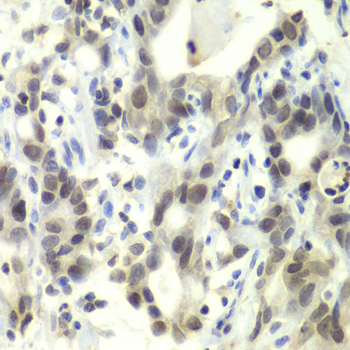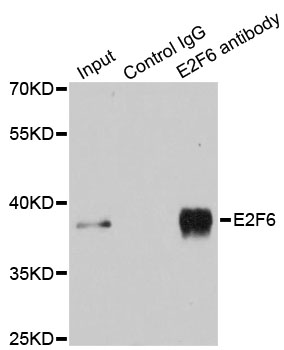-
Product Name
E2F6 Polyclonal Antibody
- Documents
-
Description
Polyclonal antibody to E2F6
-
Tested applications
WB, IHC, IF, IP
-
Species reactivity
Human
-
Alternative names
E2F6 antibody; E2F-6 antibody; transcription factor E2F6 antibody
-
Isotype
Rabbit IgG
-
Preparation
Antigen: Recombinant fusion protein containing a sequence corresponding to amino acids 1-281 of human E2F6 (NP_937987.2).
-
Clonality
Polyclonal
-
Formulation
PBS with 0.02% sodium azide, 50% glycerol, pH7.3.
-
Storage instructions
Store at -20℃. Avoid freeze / thaw cycles.
-
Applications
WB 1:500 - 1:2000
IHC 1:50 - 1:200
IF 1:50 - 1:200
IP 1:20 - 1:50 -
Validations

Western blot - E2F6 Polyclonal Antibody
Western blot analysis of extracts of MCF-7 cells, using E2F6 antibody at 1:1000 dilution.Secondary antibody: HRP Goat Anti-Rabbit IgG (H+L) at 1:10000 dilution.Lysates/proteins: 25ug per lane.Blocking buffer: 3% nonfat dry milk in TBST.Detection: ECL Basic Kit .Exposure time: 90s.

Immunohistochemistry - E2F6 Polyclonal Antibody
Immunohistochemistry of paraffin-embedded human esophageal cancer using E2F6 antibody at dilution of 1:100 (40x lens).

Immunohistochemistry - E2F6 Polyclonal Antibody
Immunohistochemistry of paraffin-embedded human gastric cancer using E2F6 antibody at dilution of 1:100 (40x lens).

Immunofluorescence - E2F6 Polyclonal Antibody
Immunofluorescence analysis of U2OS cells using E2F6 antibody . Blue: DAPI for nuclear staining.

Immunoprecipitation - E2F6 Polyclonal Antibody
Immunoprecipitation analysis of 200ug extracts of MCF-7 cells using 3ug E2F6 antibody . Western blot was performed from the immunoprecipitate using E2F6 antibody at a dilition of 1:500.
-
Background
Inhibitor of E2F-dependent transcription. Binds DNA cooperatively with DP proteins through the E2 recognition site, 5'-TTTC[CG]CGC-3'. Has a preference for the 5'-TTTCCCGC-3' E2F recognition site. E2F6 lacks the transcriptional activation and pocket protein binding domains. Appears to regulate a subset of E2F-dependent genes whose products are required for entry into the cell cycle but not for normal cell cycle progression. May silence expression via the recruitment of a chromatin remodeling complex containing histone H3-K9 methyltransferase activity. Overexpression delays the exit of cells from the S-phase.
Related Products / Services
Please note: All products are "FOR RESEARCH USE ONLY AND ARE NOT INTENDED FOR DIAGNOSTIC OR THERAPEUTIC USE"
